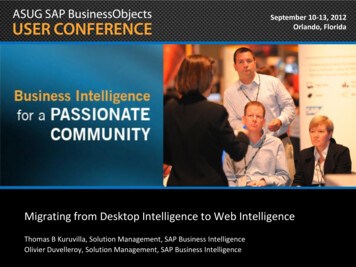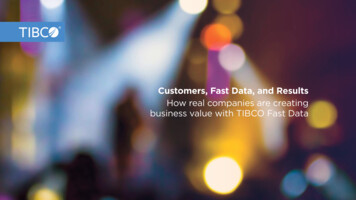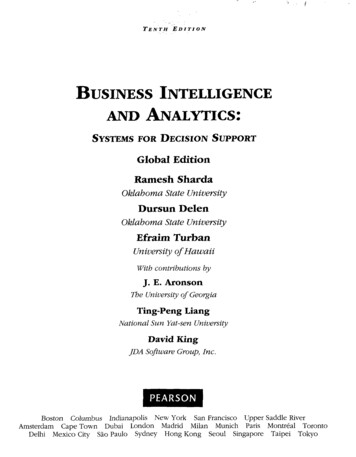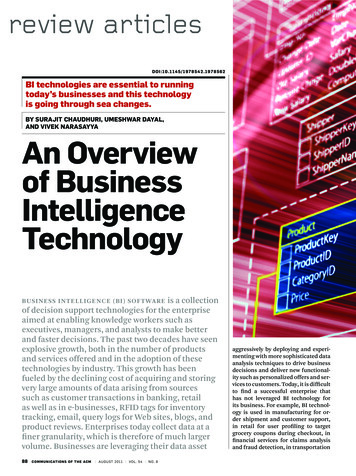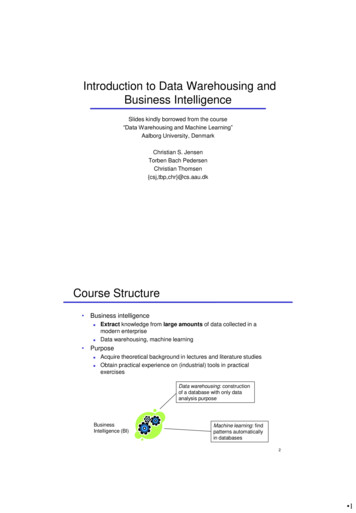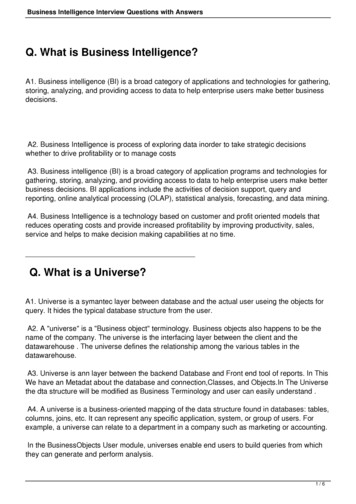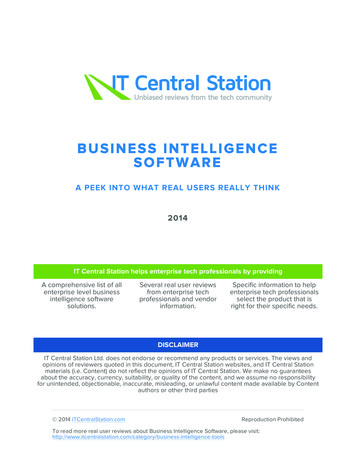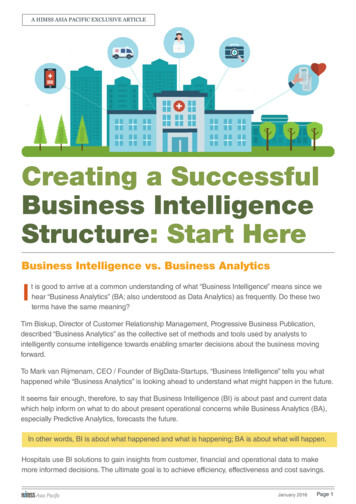
Transcription
A HIMSS ASIA PACIFIC EXCLUSIVE ARTICLECreating a SuccessfulBusiness IntelligenceStructure: Start HereBusiness Intelligence vs. Business AnalyticsIt is good to arrive at a common understanding of what “Business Intelligence” means since wehear “Business Analytics” (BA; also understood as Data Analytics) as frequently. Do these twoterms have the same meaning?Tim Biskup, Director of Customer Relationship Management, Progressive Business Publication,described “Business Analytics” as the collective set of methods and tools used by analysts tointelligently consume intelligence towards enabling smarter decisions about the business movingforward.To Mark van Rijmenam, CEO / Founder of BigData-Startups, “Business Intelligence” tells you whathappened while “Business Analytics” is looking ahead to understand what might happen in the future.It seems fair enough, therefore, to say that Business Intelligence (BI) is about past and current datawhich help inform on what to do about present operational concerns while Business Analytics (BA),especially Predictive Analytics, forecasts the future.In other words, BI is about what happened and what is happening; BA is about what will happen.Hospitals use BI solutions to gain insights from customer, financial and operational data to makemore informed decisions. The ultimate goal is to achieve efficiency, effectiveness and cost savings.January 2016Page 1
HIMSS Asia Pacific Exclusive ArticleWays in Which Business IntelligenceImproves Your Hospital’s Bottom LineCustomer SatisfactionPatients are a hospital’s customers.It would increase profits to discoverpatient behavioral patterns, understandwhat they want, when they want it andhow they want it, and deliver exactlythat. Admissions, re-admissions andward experiences can be improvedby using past and current data to gaincustomer insights.Case Study 1Hypertension suggests risk of strokeor heart attack. Through the use ofEMR, NorthShore University HealthSystem was able to better identifyhypertensive patients who were undiagnosed or at risk, thencreated algorithms to assess which patients needed additionalfollow-up. Since the new program went live, the system hasbeen used to identify, test and diagnose over 500 patients withpreviously undiagnosed hypertension.Case Study 2Staff EmpowermentBI software can equip staff withrelevant, real-time information ona dashboard or mobile device. Ifcombined with empowerment,individual staff can make informeddecisions and take appropriateactions on the spot. They will savetime searching for, or collecting data,from colleagues or relying on othercolleagues to intervene.Inventing new healthcare practices could lead tolower costs. Seoul National University BundangHospital (SNUBH), with about 1,800 beds and3,100 medical workers, has been able to reducethe usage of antibiotics before surgery by usingin-memory computing technology to improve preoperative care.Case Study 3A single healthcare platform simplifiesIT and lowers total cost of operation.MemorialCare Health System in FountainValley, California, a 2.2 billion notfor-profit integrated health system thatoperates six hospitals and 200 care sites, also uses in-memorycomputing technology to analyze massive data sets speedily andprovide a single data mart to handle transactions and detailedquestions such as “Which patients received drug X last year?”and “What is the average dose and duration of a particular drug?”.Resource OptimizationCase Study 4One of the most obvious expendituresis inventory. Excessive inventory oftenchips away at a hospital’s financialhealth. A BI solution with a gooddashboard can support hospitaladministrators in assessing whatneeds to be replenished and when.Costs can also be cut by sharinginformation, re-directing patients, andallocating resources most optimally.Our case studies provide examples.Hospitals can use BI to aid coordinationand improve bottom lines. The High ValueHealthcare Collaborative (HVHC), a collectiveof 70,000 physicians and 7 million patientsacross the U.S, found contrasting costs andprocesses for total knee replacements amongfour hospital sites, with one site performingsignificantly better than the others. When the site’s best practiceswere shared with the other three, all four cut their lengths of stayfor knee-replacement procedures by an entire day.Continued on the next page January 2016Page 2
HIMSS Asia Pacific Exclusive ArticleContinuation of Waysin Which BusinessIntelligence Improves YourHospital’s Bottom LineFraud and AnomalyDetectionFrauds can exist in the form of claimsfor patients who do not exist or fora medical procedure which is moreexpensive or not performed at all. Bydeploying BI to study people networksand genetic algorithms, it may bepossible to detect potential frauds andanomalies.Customized PresentationBI’s presentation capability canenhance communication by makingit faster, even instant, and highlyinteractive. It is able to display onlineanalytical processing and generateinsights in different ways to makethem easy to grasp and to utilize.Dashboards allow users to customizethe information they would like tomonitor and display.There is a wealth of data on the benefits of Business Intelligence. Wehave only glimpsed through a window at an ocean. To reap the mostout from the benefits of Business Intelligence, we will need the keyfundamental resource – proper and quality data.The Harsh Truth:Healthcare Data is Complex.Challenges Exist.Healthcare systems arehuge, if one considersthat healthcare could start inthe research laboratory andreach beyond secondarycaregivers.Data could give insights to solve problems but data itself is gettingmore complex. What problems and challenges do we face?We will apply a simple approach to discussing this difficult topic.Players in HealthcareHow many persons are involved in the care of a single person? Many, though theplayers are not always visible or even detectable. Here’s a pictorial ramedicPharmacistDisease Identificationand HandlingBI can be used to identify and treatdiseases by improving diagnosis.CaregiverOther MedProsMany persons could have some sort of information about the patient. However,they do not always share this information with one another. In the absence of acommon data platform, the caregiver may not have the chance to share with theattending physician that the patient tends not to finish prescribed medicines while theanesthesiologist may not be able to inform the external specialist or pharmacist of apeculiar drug allergy.Mobile app developers, lifestyle and fitness device suppliers have become part of thehealthcare systems. The human variables and the way they interact with one anotherchange all the time. How does one keep track of all these?Continued on the next page January 2016Page 3
HIMSS Asia Pacific Exclusive ArticleContinuation of The Harsh Truth: Healthcare Data is Complex Challenges ExistDifferent Types of Data on Multiple DevicesHealthcare data can be structured and unstructured, inconsistent, high volume, andperhaps, unstable, in a complex and ever-changing environment.The most basic type will be the patient’s personal health record. Patients in developedcountries presumably practice a high degree of self-management in this area. Even then,the personal health record is often mistaken for the medical record. This is the difference:The medical record is a complicatedentity with components including thefollowing: Patient’s identification details Doctor’s narrative and notes Consent for treatment Admission nursing historyPersonalHealthRecordMedicalRecord Family history X-ray and other digital/image records Medical diagnosis Ward recordsVS. Treatments and drugs Operative procedures Specific instructions or referrals Discharge plan and summaryCreated and Maintained by Healthcare ProviderCreated and Maintained by PatientGraphic re-created by HIMSS Asia Pacific. Original Source: Tacoma Community CollegeOther than records kept by healthcare providers, wireless remote monitoring devices and applications also generate important dataalong the continuum of care. Some information is also created and trapped on social media such as Facebook, Twitter and whatsapp.Could healthcare providers mine and download patient-related data into the central patient information system at sufficiently low costs?How could patient privacy and Internet security be upheld?In addition, tele-conferences between the physician and patient may not necessarily translate into information which could be analyzedtogether with text data. Medical imaging data posed another challenge. It is estimated that medical image archives are growing by20%-40% each year.Multiple SystemsInformatica highlighted in their White Paper (November 2013) titled “Healthcare DataManagement for Providers” that fragmented data across multiple systems made itdifficult for master data to be possible. This resulted in key operational problems suchas inaccurate reporting for quality improvement which compounded the problem ofcollecting master data.Robert J. Szczerba, CEO of X Tech Ventures, wrote in his 19 August 2015 articleon www.forbes.com that “without interoperable technology in place to manage andanalyze this data, much of its value will be lost.” Szczerba believed that much of theinformation became mired in separate “silos”, while medical records remain incompletewith inaccuracies. He exhorted patients to become their own health advocates, demandaccess to their health data and empower themselves to improve their health.Data ErrorsA stroke can be labeled a “cerebrovascular accident,” “cerebral occlusion,” “cerebral infarction” or “apoplexy.” Do different entries lead todifferent analysis or outcomes for patients?In a CompAct Electronic Newsletter (Issue No. 42/February 2012) titled “Why Is Health Care Data So Challenging?”, David Cusick andNathan Mathews reasoned that changing code schemes need to be updated and changed regularly to ensure data integrity. It wasreported that as ICD (International Classification of Diseases) codes get assigned to cases at the point of care, their error rates canrange from 20% to 50%.Cusick and Matthews also stated non-standard time dimensions as another unstable data field. Different healthcare personnel havedifferent ways of interpreting and entering dates. For example, the date supplied in the data may be based on the date the medical costwas incurred rather than the date the claim was paid. In some cases, the gap could be as long as a year.Data errors insidiously enter analytics. The problem of “garbage in, garbage out” makes it very challenging to get useful information.January 2016Page 4
HIMSS Asia Pacific Exclusive ArticleProblems and challenges exist but the trend of growing healthcare data is here to stay. All in the healthecosystem—organization or individual, public or private—have a role to play in balancing the risks and rewardsof harvesting and harnessing the data.A Hospital’s Roadmap toBusiness Intelligence SuccessWhat are the key targets to hit in order to achieve BI success? You may wish to consider the following:GoalsSet strategic goals forthe short termSet strategic goals forthe long termGet stakeholders’ agreementon BI goalsDataAssess current collectionand analysisAssess quality of dataIntegrate data to create aquality data warehousePeopleSelect best data expertsSelect BI drivers withenterprise-wide visibility andempowered to make decisionsCreate a dedicated departmentwith specific projectsand timelinesPlatformScrutinize options forBI platformChoose BI platform mostsuitable for your enterpriseTest and refineMeasure and monitor for outcomesRe-align and refineThese are further pointers to build up your roadmap:GoalsA mix of top-downand bottom-up designapproaches is necessaryto obtain enterprise-wideacceptance, understandingof individual and grouproles, and ultimately,success.Strategic plans shouldinclude key areas such asorganization and systemchange management,quality assurance,risk management andcommunications.The following customer’sdiagram cited in GuyGarrett’s presentation titled“How to Create a BusinessIntelligence Strategy” at theSAS Global Forum 2012may be rather useful:Stakeholder Management Subject Matter AnalysisMarketingCommissionUnderwritingAgent portunityProductDefinitionQuotation /ApplicationWIT SR’sInc MTCMember(Life)ActuarialDetailedapplication "e dataProductGrossMarginPolicyLapse tCondition /DiagnosisOperatingExpenses /ABCPMI ClaimBill /PaymentTelephoneContactFraud?Invoice /CollectionNon-PMI Business:GroupIP, GroupLife, Occ.HealthContinued on the next page January 2016Page 5
HIMSS Asia Pacific Exclusive ArticleContinuation of A Hospital’s Roadmap to Business Intelligence SuccessDataPeopleIt would help to read thissegment in conjunction withour article on “The Harsh Truth:Healthcare Data is Complex Challenges Exist”. For analyticsto be possible, hospitalshave to go beyond clinicalrepositories which do not allowanalysis to function effectively.BI is a direction and atrend which is unlikely tobe reversed. It is not hardto believe that data expertsof different sorts will be asnecessary as physicians. Datapersonnel should possessstrong analytical skills withan in-depth understanding ofhow health data is used. Muchmore can be said, but it is atopic we can explore againanother time.To consider are the databasesin a hospital which couldbe integrated into a singlewarehouse. A preliminary listwould include the following: EMR Inventory system Ambulatory Surgery Radiology Pathology ClaimsPlatformThe platform could be verycomplex in the back-end,very different from thepresentation-end. But in visualrepresentation, the parts makeup a neat integrated whole: Financial system HR f
Business Intelligence Structure: Start Here A HIMSS ASIA PACIFIC EXCLUSIVE ARTICLE January 2016 Page 1 t is good to arrive at a common understanding of what “Business Intelligence” means since we hear “Business Analytics” (BA; also understood as Data Analytics) as frequently. Do these two terms have the same meaning? Tim Biskup, Director of Customer Relationship Management, Progressive .



